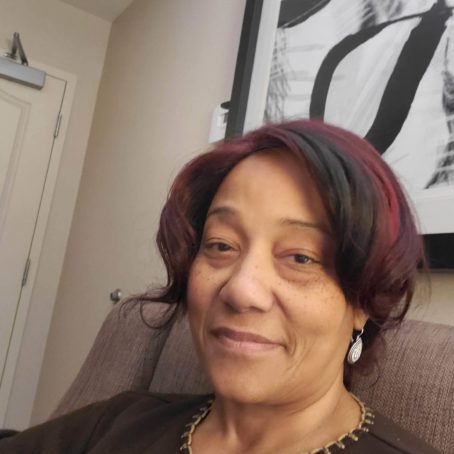From the moment she wakes up at 6 a.m. right up until she goes to sleep at 10 p.m., Glenda Gaines has to be laser-focused ― the eight children she cares for out of the second floor of a multi-family home in Boston seem to generate endless tasks. Despite having worked long hours before the pandemic, watching her young grandchildren and the children of other community members, the 62-year-old grandmother says the pandemic has added on a whole new dimension to her work: “I don’t think it ever stops.”
Not only does Gaines have to worry about setting up activities for the children in her home, she’s had to add on hours of extra cleaning time into her already packed schedule because of the pandemic regulations and her own concerns around COVID-19. “It’s a grind,” says Gaines, who has run a license-exempt early child care program since 2016 and adds that because of the pandemic, many of the families she works with have been unable to pay her because of their own financial hardships. She says that because she isn’t a part of her state’s child care subsidy, the costs of cleaning supplies, tablets and other learning materials all come out of her already stretched personal budget for now.
“The pandemic has really taken a toll not only financially, but psychologically,” says Gaines. “A lot of times I want to shut down… but you have to do it because if you don’t do it, who else is going to do it?”

Across the United States, informal providers like Gaines, also known as Family, Friend and Neighbor ― or FFN ― providers work as unlicensed caregivers to children, typically without pay, filling in the gaps left by formal networks. Roughly seven million children under the age of six are cared for by Family, Friend and Neighbor providers, according to a 2021 report from Home Grown, a non-profit focused on family child care, making it the most common form of non-parental care for young children in the country.
On average, paid FFN providers make just $7,420 a year, according to the 2016 National Survey of Early Care and Education, compared to roughly $29,377 a year in earnings for listed home-based care providers. Many FFN providers are grandparents, friends and community members, and experts say that during the pandemic they stepped up in significant ways to provide care for the families of essential workers as center care and schools either shut down or became less accessible.
However, despite the importance of this form of care, experts say that these providers, who are disproportionately women of color and have long been ignored and underinvested in, were largely left to fend for themselves during the pandemic, which has been devastating for both women of color and the child care sector writ large. Now, as the Biden administration moves to further invest in the United States’ child care infrastructure, experts say it’s imperative that Family, Friend and Neighbor providers be taken into consideration. “It’s always been a challenge, and that challenge just increased tenfold during the pandemic,” says Maki Park, a Senior Policy Analyst for Early Education and Care at the Migration Policy Institute.
A survey of informal providers from Home Grown found that nearly 40 percent of FFN caregivers were concerned about the health impacts of providing care during the pandemic. Almost a quarter of informal providers mentioned concerns over income or enrollment during the pandemic. Caregivers in the survey also reported food assistance as one of their primary support needs during COVID-19, followed by help with utilities and cleaning supplies. Most informal caregivers received little if any assistance during the pandemic, financially or otherwise, according to the National Women’s Law Center.
Even before the pandemic, equity between the informal and formal child care system, which includes both center-based care and licensed home-based providers, was a major issue, says Cleo Jacobs Johnson, an expert on child care at Mathematica.
“I take the same courses [licensed providers] have to take, and get visited just like they do. But just because I don’t have a license, I’m getting paid significantly less.”
Ana Jiminian, informal provider
Most states use some federal or state child care funding to pay for license-exempt child care, enabling providers who meet certain requirements to be reimbursed for providing care to families. However, according to a report from Home Grown, access to these subsidies and the amount they offer to pay unlicensed providers can vary wildly from state to state. For example, in nine states, unlicensed providers are unable to participate in these subsidies at all, and in most states, not only are unlicensed providers who want to participate in the subsidy program required to pass background and fingerprint checks, but every member of their household is as well, which can be prohibitory for many multi-family or mixed-immigration status homes.
“The reimbursement rate is very low, and so you go through all kinds of hoops to get the reimbursement but… it’s not at a level that is significant enough to drive people to the system,” says Jacobs Johnson. “I think about the phrase is the juice worth the squeeze for these folks — it’s not.”
Ana Jiminian, a 56-year-old informal provider in the Bronx, New York, who participates in the city’s child care subsidy program, says she knows firsthand just how unequal the payment scale of unlicensed providers can be compared to licensed providers. Despite working a full day taking care of four children, including her granddaughters, Jiminian says she is only reimbursed $13.50 per day per child in the subsidy program and that she’s still waiting on being paid by the city for a child she’s taken care of for the last three years. Day care centers are paid a daily rate of $59 to $46 per child under the age of six by the New York’s Administration for Children’s Services, according to the Day Care Council of New York. “I take the same courses [licensed providers] have to take, and get visited just like they do,” says Jiminian via a translator. “But just because I don’t have a license, I’m getting paid significantly less.”
“We’ve been doing this for many many years, not being recognized as a key alternative and not being paid … as we give just as good quality care, if not even better quality care and stability for the families and their children.”
Glenda Gaines, informal provider
For many providers, getting a license to provide child care, which could help bridge some of the pay disparities in an industry where even formal workers are underpaid and open up other resource opportunities, isn’t appropriate for the type of care they perform, says Natalie Renew, executive director of Home Grown. Language barriers, the cost of purchasing expensive equipment to meet regulation standards or meet zoning requirements, which Renew estimates can be upwards of $20,000, and concerns over their immigration status or of the members of their household can keep caregivers from becoming a part of the formal system. However, that doesn’t mean these providers don’t need or deserve robust support financially, and in the form of informational resources and connections with other providers where they can share strategies and concerns, Renew says.
For 63-year-old Ellen Supple, who watches two of her grandchildren while her son and daughter-in-law are working, becoming a part of the regulated child care system doesn’t interest her. “I’m not really looking for another career,” says Supple. “But, I think certainly having pay or some sort of compensation readily available whether it be for family members or others is really important, the cost of child care is outrageous in many respects.”
Price and flexibility are considerable drivers to Family, Friend and Neighbor providers for parents, says Jacobs Johnson. The majority of FFN caregivers do not charge parents for their services, and those who do on average charge roughly half of what center-based child care providers charge, according to a 2018 report from the National Women’s Law Center.
FFN providers also tend to have much more flexible hours, covering significant gaps for parents with non-traditional work hours like those in medical or service industries. According to the same report, roughly 63 percent of paid FFN providers cared for children under six, and approximately 82 percent of unpaid FFN providers offered care during non-standard work hours. Comparatively, only 34 percent of licensed home-based providers and just 8 percent of center-based providers offered services during non-standard hours.
Although this type of care is more prominent among individuals living in child-care deserts or experiencing economic hardships, Karen Schulman, an expert on early education at the National Women’s Law Center, says that doesn’t mean it’s not a quality choice or preference to formal child care for many families. “We think a lot in terms of formal quality measures, right ratios of teachers, education levels,” she says. “But you know, what’s really key for most parents is do I trust this provider, does this provider offer one on one nurturing care to my child?”
Moving forward, Gaines says it shouldn’t be the responsibility of parents alone to shoulder the costs of child care, especially for the lower-income families she works with, but that doesn’t mean her work should go unrecognized or unpaid.
“I feel like we should fight for the state to reimburse and pay for that service,” says Gaines. “We’ve been doing this for many many years, not being recognized as a key alternative and not being paid … as we give just as good quality care, if not even better quality care and stability for the families and their children.”


 Jessica Washington
Jessica Washington
